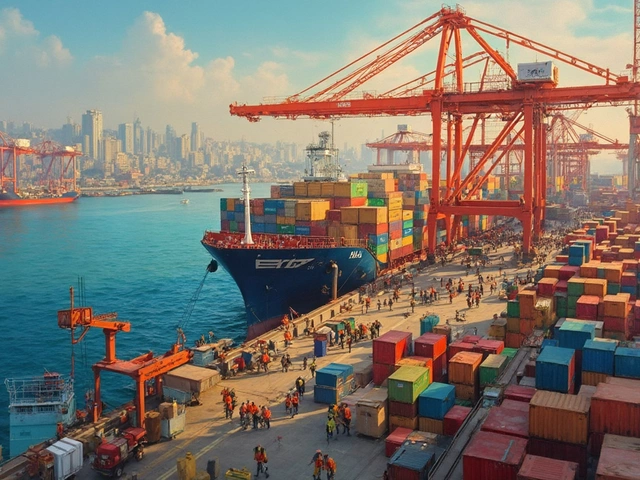Ever wondered how much it really costs to send a 20 lbs package internationally using UPS? It's not as straightforward as just looking at the weight – there's more to it. Whether you're sending a care package to a loved one or shipping products to customers abroad, understanding the cost is key to avoiding surprises.
First off, why does the destination make such a difference? Depending on where you're sending your package, different zones and rates apply. The further it goes, the more it may cost, but there are also issues like customs and tariffs that might add to your expenses.
But that's not all. Did you know that the size of your package also plays a significant role? A package that's bulkier, even if it weighs 20 lbs, might cost more due to dimensional weight pricing – a fancy term that measures the package's size against its actual weight.
- Understanding UPS Shipping Rates
- Impact of Destination on Cost
- Package Dimensions and Their Role
- Hidden Fees and Additional Charges
- Tips to Save Money on Shipping
- How to Use the UPS Shipping Calculator
Understanding UPS Shipping Rates
Shipping rates can seem like a puzzle at times, especially with UPS. But once you break it down, it's not as overwhelming. The main factors in calculating how much it's going to cost to ship a 20 lbs package come down to weight, dimensions, and destination.
Base Rate Calculation
The base rate is usually calculated using the actual weight of the package. However, if your package is large and lightweight (think big box, not much inside), UPS might factor in the dimensional weight instead. This is part of their strategy to optimize space in their delivery trucks and planes.
Destination Impact
The farther the package goes, naturally the more it costs. UPS divides locations into zones, and each zone might have different pricing. In addition, sending a package to a remote area can incur extra fees. Using the UPS rate calculator can show you what to expect for shipping to different parts of the world.
Additional Fees
Keep an eye out for extra fees. These could be for things like express delivery, Saturday delivery, or handling hazardous materials. Moreover, international shipping accounts for things like customs duties and taxes, which UPS might include in their service depending on the destination country.
Special Discounts
UPS offers discounts, especially to business accounts or when you ship frequently. If you're not using these, you could be missing out on significant savings.
Here's a quick glimpse of extra charges you might face:
| Service | Price Increase |
|---|---|
| Express Delivery | Varies per region |
| Saturday Delivery | $16 (approx.) |
| Remote Areas | $25 or more |
Understanding these factors can help you better estimate costs and maybe even strategize to save some cash next time you ship. Every step in the shipping process is designed for efficiency, but knowing these details keeps you in control of your shipping expenses.
Impact of Destination on Cost
When you're looking to ship a 20 lbs package internationally with UPS, where it's headed plays a huge role in the price. It's all about those destination zones that UPS uses to break down the world into different areas with varying rates. The further your package goes, the more you might need to fork out.
Are you sending something across the border to the U.S., or is it destined for Australia? The charges you'll face can be vastly different. For instance, sending to neighboring countries like the U.S. or Mexico might be more affordable compared to shipping to remote regions such as the Pacific Islands.
UPS Zones and Charges
UPS splits the globe into different zones, ranging from Zone 2, which might cover closer to home destinations, to Zones 8 and beyond for longer hauls. Each of these zones has its own pricing structure determined by various factors like distance, demand, and infrastructure costs of delivering to that region.
| Zone | Regions | Average Cost Increase |
|---|---|---|
| Zone 2-3 | Canada & United States | 5-10% over domestic rates |
| Zone 4-5 | Europe & Asia | 15-25% over domestic rates |
| Zone 6-8 | Australia & Africa | 30-40% over domestic rates |
Of course, this is just a rough guide, as specific costs can vary based on the country, city, and even the postal codes within those regions.
Customs, Tariffs, and More
Don't forget that your price might also sneak up due to customs duties and tariffs. Countries may impose fees on items arriving from other places. This isn't directly a UPS charge, but something that can impact your budget. Best tip? Always check the destination country's regulations before committing to a ship date.
In a nutshell, if you're planning to start shipping stuff internationally, knowing where it's heading can help you better estimate and control your costs. The more familiar you get with how international shipping works, the better you'll be at figuring out all those location-dependent expenses.
Package Dimensions and Their Role
When you're thinking about shipping a package with UPS, the weight isn't the only thing you should consider. The dimensions of your package play a huge role too, especially in international shipping. But why is that? It's all about how much space your package takes up in a delivery truck or plane.
Ever heard of something called dimensional weight pricing? This is where things get interesting. If your package is large but lightweight, you might end up paying more because of the space it occupies, not the actual weight.
Understanding Dimensional Weight
Dimensional weight, sometimes called volumetric weight, is calculated by taking the package's length, width, and height. UPS will then use this formula: (Length x Width x Height) / 139 for packages in inches. They compare this number to the actual weight in pounds and charge you based on whichever is greater.
Why Does This Matter?
Let's say you’re shipping a 20 lbs package. If it's compact, no big deal. But if it's got some awkward dimensions, you might find yourself paying like it's 30 lbs instead due to the space it takes up. Knowing this helps you pack smarter and save money.
How to Measure Properly
- Use a tape measure to measure the longest point of each dimension: length, width, and height.
- Round each measurement to the nearest whole number.
- Use the dimensional weight formula mentioned above to see if it exceeds the actual weight.
Understanding how your package dimensions affect costs can save you unexpected fees. Aim for more compact packaging when possible, and always compare the dimensional weight to the actual weight before shipping.

Hidden Fees and Additional Charges
Shipping internationally with UPS comes with more than just the basic shipping cost. There are often hidden fees and additional charges that can creep up and impact your budget, so it's crucial to be aware of these potential expenses.
Duties and Taxes
When you send a package across borders, you might encounter duties and taxes imposed by the destination country. These are not controlled by UPS but by the local government, so it's worth checking what these could be before shipping. Remember, it's often the recipient who will have to pay these charges, so a heads-up can save some unexpected surprises.
Fuel Surcharges
UPS, like many carriers, applies a fuel surcharge that reflects the fluctuating costs of fuel. This surcharge can vary and is updated regularly. Keeping an eye on fuel prices can give you a rough idea of what to expect in terms of these additional charges.
Remote Area Delivery Fees
If your package is going to a remote area, a delivery fee might be tacked on. UPS defines remote areas based on accessibility and distance from major centers, so if your package is headed to a less traveled destination, it's likely you'll see this charge.
- UPS shipping can include add-on services like signature confirmation or insurance that, while optional, can add to your bill.
- Don't forget about size fees, which can kick in if your package is deemed 'oversize' despite the weight.
If you're a stickler for details, the UPS website provides a great resource breakdown of these charges. You can also contact them directly for clarifications tailored to your specific needs.
| Fee Type | Rate |
|---|---|
| Fuel Surcharge | Varies |
| Duties and Taxes | Destination-specific |
| Remote Area Fee | Based on location |
Being informed about these extra charges helps avoid nasty surprises and ensures that your international shipping plan goes smoothly.
Tips to Save Money on Shipping
Shipping doesn't have to break the bank, even when you're dealing with a package that tips the scales at 20 lbs. Here are some proven ways to keep your UPS shipping costs in check.
1. Compare Rate Options
Before committing to a shipping option, take a look at the different rates and services UPS offers. Sometimes, opting for a slightly longer delivery time can save you a significant amount. Consider if you really need express shipping or if standard delivery might do just fine.
2. Pack Smart
Make sure your packages aren't bigger than they need to be. UPS rates often depend not just on weight but on dimensional weight — basically, how much space your package takes up. Use the smallest box that safely fits your items to keep those costs down.
3. Use UPS Tools
Tapping into tools like the UPS shipping calculator can provide a clear estimate of your shipping costs. This means you're less likely to face unexpected charges, and you can make informed decisions based on accurate forecasts.
4. Consolidate Shipments
If you're planning to send multiple items, try to combine them into a single shipment. It might cost less overall than sending multiple separate packages.
5. Leverage Discounts
Many businesses can access shipping discounts by signing up for a UPS account or through partnerships with marketplaces. Sometimes, it's as easy as asking if they offer any rate reductions for frequent shippers.
6. Stay Informed on Tariffs
When shipping internationally, keep an eye on customs fees and tariffs. These can sneak up and inflate your costs. Familiarize yourself with destination countries' regulations to avoid surprises.
| Tip | Potential Savings |
|---|---|
| Compare Rate Options | 5-15% |
| Pack Smart | 10-20% |
How to Use the UPS Shipping Calculator
When it comes to figuring out the cost of shipping a 20 lbs package internationally with UPS, the UPS Shipping Calculator is your best friend. This handy tool helps you get a detailed estimate based on various shipping factors.
Step-by-Step Instructions
- Access the Calculator: Head over to the UPS website. Look for the 'Calculate Time and Cost' tool – usually, it's right there on the main menu.
- Enter Your Shipping Information: Key in the origin and destination addresses. Precise addresses ensure the calculator considers the right destination zone, affecting rates.
- Provide Package Details: Besides weight, enter dimensions like length, width, and height. The calculator uses this info to determine if dimensional weight applies.
- Select Shipping Date: Choose when you're planning to ship. Some delivery options, like overnight, depend heavily on the shipping date.
- Choose Service Options: Go through available shipping methods. Depending on your urgency, you might opt for Express or Saver services.
Why Use the Calculator?
The calculator isn't just about pricing. It provides estimated delivery times and any additional fees upfront. It's a lifesaver for businesses planning shipping expenses.
“In the logistics industry, understanding costs ahead of shipping makes all the difference in both budgeting and customer satisfaction,” says Chris Billingsley, a logistics consultant.
Additional Tips
- Compare Rates: Use the results to compare different shipping options based on price and delivery speed.
- Consider Insurance: If your package is valuable, review insurance options during checkout.
Remember, using the UPS Shipping Calculator effectively takes a bit of practice but mastering it can help you avoid unexpected costs and streamline your shipping process. And who doesn’t want to save both time and money?





